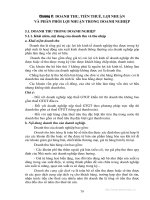Bài giảng international corporate finance Tài chính doanh nghiệp quốc tế EngVi
Bạn đang xem bản rút gọn của tài liệu. Xem và tải ngay bản đầy đủ của tài liệu tại đây (8.6 MB, 278 trang )
1
Globalization, International Trade and FDI
(Chapters 2 & 13)
How firms engage in international business
(1)
International payment (19)
Exchange rate determination (4 & 8 &10)
International capital budgeting (14)
International capital structure (17)
Short-term and long-term financing (18 &
20)
Currency derivative (5)
2
The learning objectives for this unit are:
the
the
the
the
meaning of globalisation;
‘architecture’ of globalisation;
main trends in the global economy; and
impact of globalisation
3
In the world economy today, there is:
a shift away from self-contained national economies with high
barriers to cross-border trade and investment;
a move toward a more integrated global economic system with
lower barriers to trade and investment;
about $3 trillion in foreign exchange transactions taking place
everyday;
over $12 million of goods and some $3 trillion of services being
sold across national borders; and
the establishment of international institutions.
4
4
5
The effects of this globalisation can be seen in the:
cars people drive;
food people eat;
jobs where people work; and
clothes people wear.
RMIT University©02/24/17
6
6
Globalization refers to the trend towards a more integrated
global economic system.
Two key facets of globalization are:
the globalization of markets; and
the globalization of production.
7
7
The globalization of markets refers to the merging of historically
distinct and separate national markets into one global
marketplace;
In many markets today, the tastes and preferences of consumers
in different nations are converging upon some global norm;
and
Examples of this trend include Coca Cola, Starbucks, Sony
PlayStation, and McDonald’s hamburgers
8
8
The globalization of production refers to the sourcing of goods and
services from locations around the globe to take advantage of national
differences in the cost and quality of factors of production (labor energy,
land, and capital);
The goal for companies is to lower their overall cost structure or improve
the quality or functionality of their product and gain competitive
advantage; and
Examples of companies doing this include Volvo, Boeing and many
computer hardware companies.
9
9
Global institutions have emerged to:
help manage, regulate, and police the global market place; and
promote the establishment of multinational treaties to govern the
global business system.
World Trade Organization (WTO) which is responsible for
policing the world trading system and ensuring that nations adhere
to the rules established in WTO treaties
◦ In 2008, 151 nations accounting for 97% of world trade were
members of the WTO;
International Monetary Fund (IMF) which maintains order in the
international monetary system;
World Bank which promotes economic development; and
United Nations (UN) which maintains international peace and security,
develops friendly relations among nations, cooperates in solving
international problems and promotes respect for human rights, and
is a center for harmonizing the actions of nations.
10
10
There are two macro factors underlying the trend toward greater
globalization:
1.
declining trade and investment barriers; and
2.
technological change.
11
11
Lower trade barriers enable companies to view the world as a
single market and establish production activities in optimal
locations around the globe;
This has led to an acceleration in the volume of world trade and
investment since the early 1980s
12
12
The development of the microprocessor has lowered the cost of
global communication and therefore the cost of coordinating and
controlling a global organization;
Web-based transactions have grown from virtually zero in 1994 to
$250 billion in 2007 in the U.S. alone, and Internet usage is up
from fewer than 1 million users in 1990 to 1.3 billion users in
2007;
Commercial jet aircraft, super freighters and the introduction of
containerization have greatly simplified trans-shipment from one
mode of transport to another
Low cost communications networks have helped create electronic
global marketplaces; and
Low cost transportation has enabled firms to create global markets,
and have facilitated the movement of people from country to
country promoting a convergence of consumer tastes and
preferences.
13
13
Rapid economic growth is now being experienced by countries
such as China, India, Thailand, and Malaysia;
Forecasts predict a rapid rise in the share of world output
accounted for by developing nations such as China, India,
Indonesia, Thailand, and South Korea, and a decline in the
share by industrialized countries such as Britain, Japan, and
the United States; and
Organizations are finding both new markets and new
competitors in the developing regions of the world
14
14
The Changing Demographics of World GDP and Trade
15
15
The share of world output generated by developing countries
has been steadily increasing since the 1960s; ****HOW?
*********
The stock of foreign direct investment (total cumulative
value of foreign investments) generated by rich industrial
countries has been on a steady decline; and
There has been a sustained growth in cross-border flows of
foreign direct investment.
RMIT University©02/24/17
16
16
Percentage Share of Total FDI Stock, 1980 - 2006
17
17
FDI Inflows, 1988 - 2007
18
18
A multinational enterprise is any business that has productive
activities in two or more countries:
While most international trade and investment is conducted by
large MNEs, many small and medium-size firms are expanding
internationally and the Internet has made it easier for many
smaller companies to build international sales;
Today, many markets that had been closed to Western firms are
open;
The collapse of communism in Eastern Europe has created a host
of export and investment opportunities;
Economic development in China has created huge opportunities
despite continued Communist control;
Free market reforms and democracy in Latin America have created
opportunities for new markets and new sources of materials and
production, and
A more integrated global economy presents new opportunities for
firms, but it can also result in political and economic disruptions
that may throw plans into disarray
19
19
Critics of globalization worry that jobs in advanced economies are
being lost to low-wage nations;
Supporters of globalization disagree, claiming that the benefits of
free trade outweigh its costs and while some jobs may be lost,
the economy as a whole is better off; and
Supporters argue that free trade will result in countries specializing
in the production of those goods and services that they can
produce most efficiently, while importing goods and services that
they cannot produce as efficiently, and that in doing so, all
countries will gain.
RMIT University©02/24/17
20
20
Critics of globalization argue that that free trade encourages
firms from advanced nations to move manufacturing facilities
offshore to less developed countries with lax environmental
and labor regulations;
Supporters of free trade point out that tougher environmental
regulation and stricter labor standards go hand in hand with
economic progress and that as countries get richer as a result
of globalization, they raise their environmental and labor
standards; and
Free trade does not lead to more pollution and labor
exploitation, it leads to less.
21
21
Critics of globalization worry that economic power is shifting
away from national governments and toward supranational
organizations such as the WTO, the European Union (EU), and
the UN;
Supporters of globalization argue that the power of these
organizations is limited to what nation-states collectively
agree to grant;
The organizations must be able to persuade members states to
follow certain actions; and
Without the support of members, the organizations have no
power.
22
22
Critics of globalization argue that the gap between rich and poor
is wider and that the benefits of globalization have not been
shared equally;
Supporters of free trade suggest that the actions of governments
have made limited economic improvement in many countries;
and
Many of the world’s poorest nations are under totalitarian
regimes, suffer from endemic corruption, have few property
rights, are involved in war, and are burdened by high debt.
23
23
Countries differences require companies to vary their practices
country by country;
Managers face a greater and more complex range of problems;
International companies must work within the limits imposed by
governmental intervention and the global trading system; and
International transactions require converting funds and being
susceptible to exchange rate changes
24
24
25









